
Milk is a white liquid food produced by the mammary glands of mammals. It is the primary source of nutrition for young mammals before they are able to digest solid food. Immune factors and immune-modulating components in milk contribute to milk immunity. Early-lactation milk, which is called colostrum, contains antibodies that strengthen the immune system and thus reduce the risk of many diseases. Milk contains many nutrients, including protein and lactose.

The Holstein Friesian is an international breed or group of breeds of dairy cattle. It originated in the Dutch provinces of North Holland and Friesland and in Schleswig-Holstein in northern Germany. It is the dominant breed in industrial dairy farming worldwide, and is found in more than 160 countries. It is known by many names, among them Holstein, Friesian and Black and White.

Dairy cattle are cattle bred for the ability to produce large quantities of milk, from which dairy products are made. Dairy cattle generally are of the species Bos taurus.

The Nigerian Dwarf is an American breed of dwarf goat. Like the American Pygmy Goat, it derives from the West African Dwarf group of breeds of West Africa.
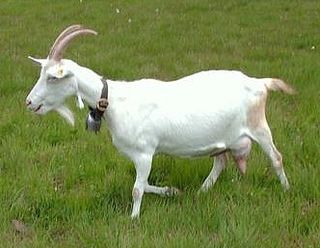
The Saanen is a Swiss breed of domestic goat. It takes its name from the Saanental in the Bernese Oberland, in the southern part of the Canton of Bern, in western Switzerland. It is a highly productive dairy goat and is distributed in more than eighty countries worldwide.

The Toggenburger or Toggenburg is a Swiss breed of dairy goat. Its name derives from that of the Toggenburg region of the Canton of St. Gallen, where it is thought to have originated. It is among the most productive breeds of dairy goat and is distributed world-wide, in about fifty countries in all five inhabited continents.

Goat milk is the milk of domestic goats. Goats produce about 2% of the world's total annual milk supply. Some goats are bred specifically for milk. Goat milk naturally has small, well-emulsified fat globules, which means the cream will stay in suspension for a longer period of time than cow's milk; therefore, it does not need to be homogenized. Eventually, the cream will rise to the top over a period of a few days. If the milk is to be used to make cheese, homogenization is not recommended, as this changes the structure of the milk, affecting the culture's ability to coagulate the milk and the final quality and yield of cheese.

The Anglo-Nubian is a British breed of domestic goat. It originated in the nineteenth century from cross-breeding between native British goats and a mixed population of large lop-eared goats imported from India, the Middle East and North Africa. It is characterised by large, pendulous ears and a convex profile. It has been exported to many parts of the world, and is found in more than sixty countries. In many of them it is known simply as the Nubian.
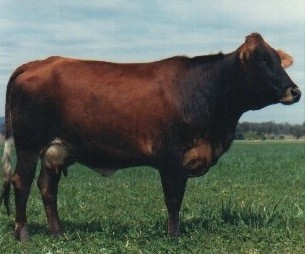
The Australian Friesian Sahiwal, is an Australian breed of dairy cattle whose development commenced in the 1960s by the Queensland Government. It is a combination of the Sahiwal, a dairy breed of Bos indicus from Pakistan and Holstein breeds, designed for the tropical regions of Australia. Cows produce approximately 3,000 litres of milk per lactation under tropical pasture conditions with a high resistance to heat, humidity, ticks and other parasites.
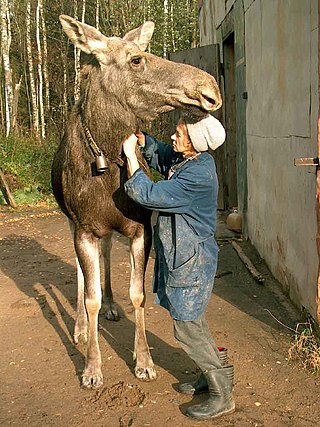
Moose milk, also known as elk milk, refers to milk produced by moose. Though it is most commonly consumed by moose calves, its production has also been commercialised in Russia, Sweden and Canada.

The Lacaune is a breed of domestic sheep originating near Lacaune in southern France. The native region of these sheep is the Tarn and Aveyron departments and surrounding areas. This region is collectively known as the "Roquefort Sector" which references the milk collection area. The Lacaune is the most widely used dairying sheep breed in France, with a population of about 800,000 ewes. Notably, it is the predominant breed used in the production of Roquefort cheese in France.

The goat or domestic goat is a domesticated species of goat-antelope typically kept as livestock. It was domesticated from the wild goat of Southwest Asia and Eastern Europe. The goat is a member of the animal family Bovidae and the tribe Caprini, meaning it is closely related to the sheep. There are over 300 distinct breeds of goat. It is one of the oldest domesticated species of animal, according to archaeological evidence that its earliest domestication occurred in Iran at 10,000 calibrated calendar years ago.
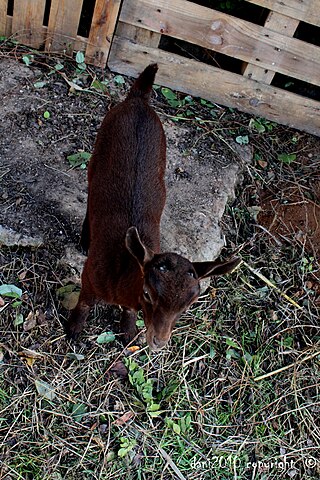
The Murciano-Granadina is a Spanish breed of dairy goat. It was created in 1975 when two existing breeds, the mahogany-coloured Murciana of Murcia and the black Granadina of Granada, began to be hybridised as a result of the official recognition of a single herdbook including both breeds. It is the most important dairy goat breed of Spain, with more than 500,000 milking females. It originated in the semi arid areas in south eastern Spain, including parts of Murcia, Almería, Granada and Alicante. They were bred for two main traits, milk production and its ability to continue this production in dry and nutrient poor regions. They have been introduced into several areas in Latin America as well as northern Africa.
The British Milksheep is a robust, dual-purpose sheep commonly known for its milking characteristics.

Norwegian Red is a breed of dairy cattle developed in Norway since 1935. Since the 1970s, breeders strongly emphasized functional and production traits resulting in excellent production combined with world-leading performance in health and fertility traits. Norwegian Red cows can have either a red and white or black coat and have a high proportion of genetically polled animals.

American Lamancha, or more commonly, simply Lamancha or LaMancha, is a formally recognized breed of dairy goat, first bred in California by Mrs. Eula Fay Frey about 1927. Later she moved the herd to Glide, Oregon for further development. The Lamancha goat is a member of the Capra genus, specifically Capra aegagrus hircus, like all domestic goats.
The American Dairy Goat Association or ADGA is a United States not-for-profit corporation dedicated to dairy goats. Its purpose is to promote the dairy goat industry, by providing and circulating sound information about goats and goat's milk; maintaining and publishing herd books and production records of milk goats; and issuing certificates of registration and recordation; improving and developing the milk goat breeds; and providing publicity and service for the goat dairying industry. The principal operation of the corporation is in Columbia, Missouri, and its headquarters are in Spindale, North Carolina.
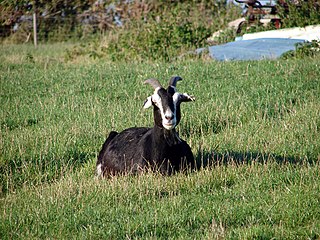
The British Alpine goat is a breed of domestic goat developed in the early 1900s. A standard British Alpine goat is black all over with white 'Swiss' markings. Another well-known breed that has these markings is the Toggenburg goat, and the breed was developed from the Toggenburg, native British goats, and Nubian genetics. The British Alpine is a high producer of quality goats' milk, and the breed can be found in many goat dairies as an acceptable milker. These goats are capable of extended lactations, sometimes even lasting close to two years.

A dry cow refers to a dairy cow that is in a stage of their lactation cycle where milk production ceases prior to calving. This part of their lactation cycle is referred to as the cows dry period and typically last between 40 and 65 days. Dry cows are typically divided into two groups: far-off and close-up. Once the cow has entered this stage, producers will seal the cows teat while following a veterinarian recommended, dry cow therapy for their herd. This dry period is a critical part of their lactation cycle and is important for the cows health, the newborn calf and future milk production, as it allows the cow time to rest, eat and prepare for birth. During this time, the cow will produce colostrum for the newly born calf.
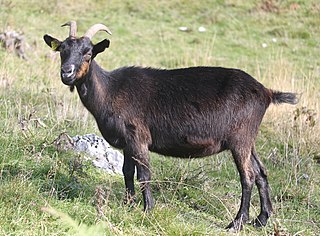
Drežnica goat is an autochthonous breed of goat, originating in Slovenia, Posočje. Currently it is the only goat breed being listed among Slovenian either autochthonous either traditional breeds of domestic animals. Animals of this breed are middle-sized darker goats, that are being used both for production of milk and dairy products as well as obtaining goat meat.



















